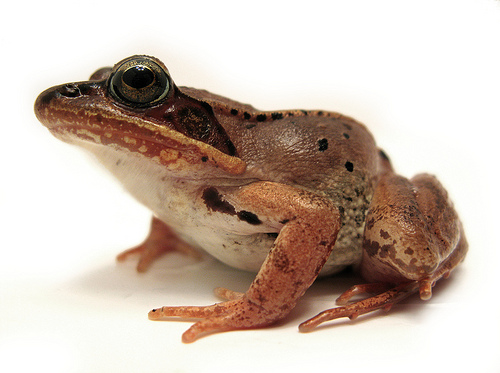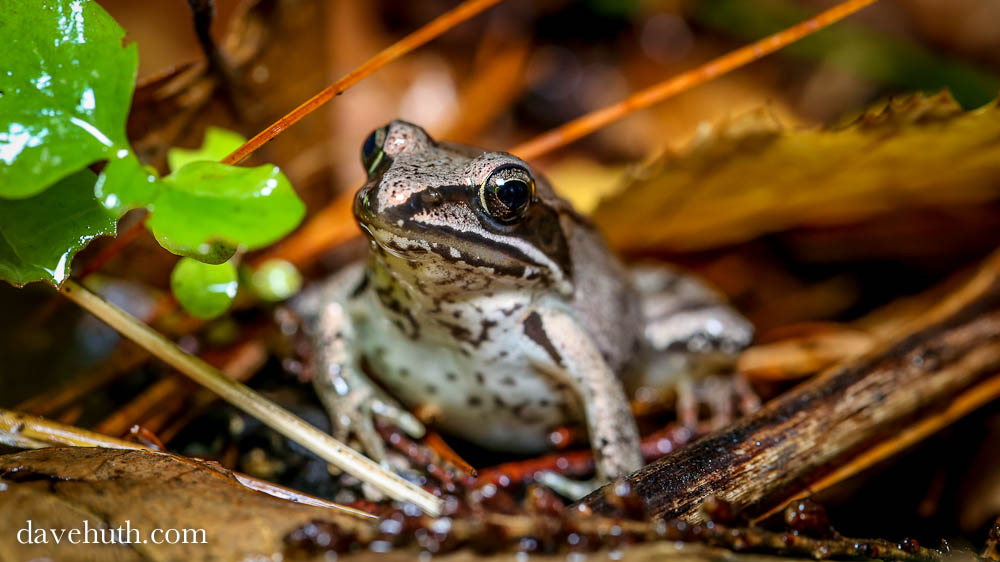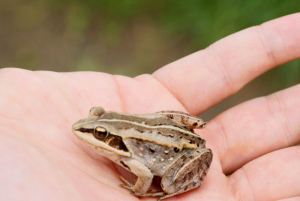Wood frogs (Lithobates sylvaticus) freeze solid over winter and come back to life in spring
by Karen McDonald
Here in North America there are a wide variety of toads and frogs, but perhaps none are so unusual as the wood frog. These frogs are found in Eastern North America, Canada, and up into Alaska. On a warm spring night you might hear them singing(click here for sound clip) near bogs, vernal pools or upland forests, but something remarkable happens to them this time of year in the winter: They freeze solid. Now freezing solid isn’t remarkable by itself, but what is remarkable is that the frogs will literally come back to life in the spring, after having no heartbeat or brain activity (they don’t even breathe) for up to eight weeks! This baffles and amazes scientists, who are actively studying them even now.
Wood frogs are amphibians, and exotherms, which means that their internal body temperatures are affected by their surroundings. But unlike their relatives, they do not hibernate deep in ponds or lakes or bury into the leaves and mud of stream banks. During winter most amphibians go into a period of dormancy, but they don’t freeze solid. Their cells and bodies stay relatively thawed, though cool, and they are inactive until the warmer weather returns.
So How and Why Do Wood Frogs Freeze?
There are different schools of thought about why wood frogs freeze solid, but one of the ideas is that they freeze so that they are the first ones “up” in the spring. A remarkable part of their natural history is that wood frogs move around a lot. They migrate to spend summer months in upland forests, but around fall and winter they move towards the uplands and slopes surrounding their preferred vernal pools (pools that dry up after filling with water in the spring). Because these frogs depend on vernal pools, which might dry up very early in summer, it makes sense they they would want to “get a jump” on the competition for the pools by waking up early in spring and laying eggs as early as possible. Because the upland forests and the ground in which they hibernate thaw earlier than the water and mud in which other amphibians hibernate in, the wood frogs wake up earlier than most frog species. In the spring they are one of the first frogs to emerge, along with Spring Peepers.
So how does this freezing solid stuff work? Okay, time for the sciency information. If you remember, most living things are made out of water. Well, the wood frog is too, which means that water plays a crucial part of the freezing and thawing process. Birds, reptiles, and amphibians secrete waste in the form of uric acid. This is the white pasty stuff that you find on your windshield. Uric acid is an efficient way to remove waste because it is insoluble (doesn’t dissolve) in water and allows water to be reabsorbed into their bodies where it’s needed while the waste is passed on out the poop shoot. Wood frogs have found a way to use this uric acid, along with a type of sugar that they create inside their bodies, to help them in the freezing process.
When the temperature drops outside, and the world begins to freeze, the wood frog begins to accumulate uric acid in its tissues. Along with this the frogs also begin converting glycogen (sugars) in their liver and distributing this throughout their body tissues. Glycogen and urea are important because they act to limit the amount of ice that forms INSIDE the cells of the frog’s body, while allowing ice to form outside of the frog’s cells. When the frog begins to freeze it draws water from the inside of its cells into its body cavity, and the water surrounds the major organs inside of it. The uric acid and glycol prevents the small amount of water that remains inside the cells of the frog’s organs from freezing, but the water surrounding the organs, heart, etc. all freezes solid.
In the spring the most amazing part of this process happens. When the temperature goes above freezing, the frog begins to thaw. Now common sense would say that the frog would begin to thaw from the outside in, but it doesn’t happen this way. The frog actually begins thawing from the inside out! No one is sure how this happens or how the frog even starts its heart beating again.
Watch this incredible video by Robert Krulwich on PBS.
What can we learn from wood frogs?
There are many applications that scientists and researchers are trying to learn from wood frogs. Could they give us a clue to cryogenics (freezing and waking up humans)? Could they help us unlock the mystery of diabetes? After all, wood frogs can withstand blood sugar (glucose) levels nearly 100 times higher than normal without suffering ill effects. Humans can only manage blood sugar levels around two to 10 times higher (NPS Gates of the Arctic). People in the field of biomimicry (learning from nature) are are looking at wood frogs and their biology to create new forms of antifreeze that might be used in vehicles or machines that operate in cold temperatures.When walking in the woods this winter, think about the wood frog-cicles frozen underground waiting to re-emerge in the spring. They are truly one of nature’s miracles.
Karen McDonald is a guest blogger, curriculum developer, science content editor and outdoor educator with over 13 years in informal science education. She has an MS in Biology and a BS in Environmental Science and Philosophy. Currently she works for the Smithsonian and contracts for Discovery Channel. Visit her blog at The Infinite Spider.
Wood frogs photos by Dave Huth used with permission under the Flickr Creative Commons License here.





Truly fascinating article. Who knew?
Thanks for sharing this info about wood frogs . You have a way with words and critters!
Awesome.i love frogs
Hi Karen,
I’ve read that turtles (probably Painteds), can also partially freeze during Winter and re-animate once Spring arrives. Are you aware of those studies as well?
You’re correct, there are some species, especially painted turtles. They don’t completely freeze, like wood frogs, but they do maintain some amino acids and partially “unfrozen” segments of their bodies. Here are a couple of articles you might want to check out:
http://ajpregu.physiology.org/content/262/3/R530.short
http://www.jstor.org/stable/1446492?seq=1#page_scan_tab_contents
http://link.springer.com/article/10.1007/BF00263600#page-1
How can wood frog survive in polar region?
They can stop their vital systems and essentially hibernate. Throughout this time they do not want to eat or drink. When the polar region becomes just warm enough for the frog to find food, it will start it’s systems again, find food, and finally go back into its hibernating state.
thanks for the interesting article